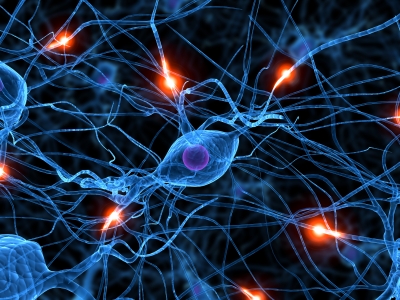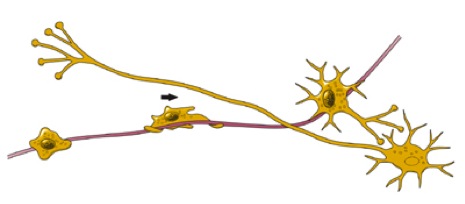Rhesus Monkeys and Biological Addiction
Biology 342 Fall 2012
by Chrissy Schmidt and Liz Pekarskaya
| Home | Phylogeny | Ontogeny | Mechanism | Adaptation | References | Course Home |
Ontogeny
Ontogeny is the develoment of an organism over the course of a lifetime. Addiction has several important implications for development including addictive substances are often teratogens, or chemicals that cause birth defects[15] and they can cause epigenetic changes such as a predisposition to become addicted to a sunstance if the epigenetic mechaisms either up-regualte or down-regualte certain genes and histones by methylation or aceytlation (see more about methylation and acytlation below).[16]
How do neurons develop and how do they change with addiction?
Neurons are electrically excitable cells that transmit information in the central nervous system. They develop in the embryonic phase and continue to change throughout life.

Above is a picture representation of neurons in the brain.
Myth: A person is born with all the neurons they will have in their life.
The myth was part of the dogma (central ideas of the field) of neuroscience until the 1970’s until a few papers, notably by Joseph Altman and Gopal Das in the 1960’s using rats were published. The findings were not taken as fact through until the early 1990's. Fernando Nottebohm and Michael Kaplan in 1989 used birds to show the existence of neurogenesis. Neurogenesis is the birth or creation of new neurons through either the neural stem or progenitor cells in the hippocampus and sub ventricular zone of the brain. Surprisingly the first wave of research about neurogenesis in adult monkey brain was between 1999-2002 by Elizabeth Goul, Fred Gage, and Peter Eriksson; over thirty years after the idea was introduced .
The idea of the creation of a neuron begins with neural stem cells. Stem cells can divide into multiple cells (mitosis), and then differentiate into specialized cells in the brain. There are also stem cells throughout the adult body, but they are usually small in number. In the brain, the stem cells undergo mitosis and differentiate into the specific type of neuron the brain needs then the new neuron must migrate to the location in the brain where it is needed.
The Picture illustrates a neuron gliding on glia and showing the progression of a new neuron creating connections to its environment.[14]There are two accepted ways scientists believe neurons move are:
1. Chemical signals
2. Neurons glide along radial gliaOnce the neuron gets to its destination in the brain, then it will begin to differentiate or to fit into the environment. The cell will begin to have dendrites and an axon and become a specialized cell; for example, sensory neuron or motor neuron.
Effects of Cocaine on neurons
General
Cocaine is a stimulant or “upper”, its main function is flooding the brain with dopamine mainly in the nucleus accumbens and prefrontal cortex. Dopamine is a neurotransmitter that plays a major role in pleasure-driven learning. The cocaine causes an increase in the neurotransmitter, then the neurons can absorb more dopamine through the many type’s dopamine receptors (D1, D2, D3, D4, D5) which creates the ‘good feeling’ or high. However, there becomes more of the neurotransmitter in the brain than there are available receptors. Once the high is gone, the withdrawal usually creates ‘bad feelings’ because the levels of dopamine are returning to normal i.e. the pleasure is gone from the excess dopamine and it does not give the same good feeling. Addictive behavior comes when animals wants the reward-feeling from the excess dopamine. Usually dopamine levels increase when animals are engaged in sex, food, drugs, rewarding experiences, and possibly aggression. [22]
Chronic Administration
When neurons are exposed to chronic use of cocaine they adapt to the large fluxes in dopamine and other neurotransmitter levels by decreasing the amount of receptors on the neurons. Neurons can adapt to add more or less receptors on the neurons but the brain wants to try to keep the amount of neurotransmitter relatively stable, and not have the large changes in uptake. This usually leads the animal to think it needs more drugs because the “good feeling” is not as strong as before.
Epigenetics
Epigenetics is the study of heritable changes in gene expression caused by other mechanisms than a change in the nucleotide sequence of DNA. The methylation of histones has a large role in the behavior of addiction, and cocaine abuse alters the expression of histones.
A study on rats with administration of HDAC inhibitors (histone deacetylase is an enzyme that takes off acetyl groups from amino acids) can reduce the cravings for cocaine. This displays that genes are linked to why animals can become addicted to certain substances or activities. The HDAC inhibitors can help to reduce the risk of relapse in the study with rats and helps prevent addiction all together. [23]
Below is a picture from Science magazine that represents ways DNA can be relguated do to epigenetic mechanisms. 
Another example of how epigenetics plays a role in addiction is from Eric Nestler’s lab in Mount Sinai Medical Center in New York City. It found that cocaine use leads to decreased methylation of a specific histone in nucleus accumbens and increase in acetylation which regulates brain reward-circuit activity. The decrease in methylation creates sensitivity to the drugs effects and makes the animal want more of the drug after the first use. [22]
